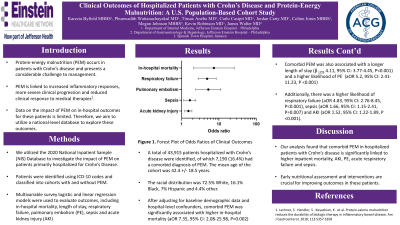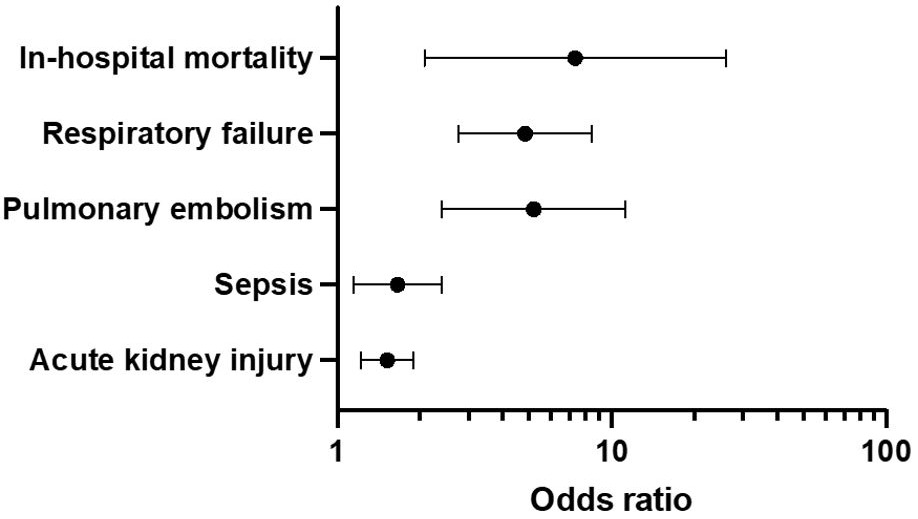Sunday Poster Session
Category: IBD
P0928 - Clinical Outcomes of Hospitalized Patients With Crohn’s Disease and Protein Energy Malnutrition: A U.S. Population-Based Cohort Study
Sunday, October 27, 2024
3:30 PM - 7:00 PM ET
Location: Exhibit Hall E

Has Audio

Karecia Byfield, MBBS
Albert Einstein Medical Center
Philadelphia, PA
Presenting Author(s)
Karecia Byfield, MBBS1, Phuuwadith Wattanachayakul, MD1, Tinsae Anebo, MD1, Carlo Gabriel C. Casipit, MD1, Jordan Carty, MD1, Colton F. Jones, MBBS1, Megan Johnson, MBBS2, Kevin Robinson, MD1, James Walter, MD3
1Albert Einstein Medical Center, Philadelphia, PA; 2Spanish Town Hospital, Kingston, Saint Andrew, Jamaica; 3Einstein Healthcare Network, Philadelphia, PA
Introduction: Protein-energy malnutrition (PEM) occurs in patients with Crohn's disease presenting a considerable challenge to management. PEM is linked to increased inflammatory responses, more severe clinical progression and reduced clinical response to medical therapies. However, data on the impact of PEM on in-hospital outcomes for these patients is limited. Therefore, we aim to utilize a national-level database to explore these outcomes.
Methods: We utilized the 2020 National Inpatient Sample (NIS) Database to investigate the impact of PEM on patients primarily hospitalized for Crohn's disease. Patients were identified using ICD-10 codes and classified into cohorts with and without PEM. Multivariable survey logistic and linear regression models were used to evaluate outcomes, including in-hospital mortality, length of stay, respiratory failure, pulmonary embolism (PE), sepsis, and acute kidney injury (AKI).
Results: A total of 43,915 patients hospitalized with Crohn's disease were identified, of which 7,190 (16.4%) had a comorbid diagnosis of PEM. The mean age of the cohort was 42.4 ± 18.5 years. The racial distribution was 72.5% White, 16.1% Black, 7.0% Hispanic, and 4.4% other. After adjusting for baseline demographic data and hospital-level confounders, comorbid PEM was significantly associated with higher in-hospital mortality (aOR 7.35, 95% CI: 2.08-25.98, P=0.002) and a longer length of stay (βLOS 4.11, 95% CI: 3.77-4.45, P< 0.001). Additionally, patients with comorbid PEM had a higher likelihood of PE (aOR 5.2, 95% CI: 2.41-11.23, P< 0.001), respiratory failure (aOR 4.83, 95% CI: 2.76-8.45, P< 0.001), sepsis (aOR 1.66, 95% CI: 1.15-2.41, P=0.007), and AKI (aOR 1.52, 95% CI: 1.22-1.89, P< 0.001).
Discussion: Our analysis found that comorbid PEM in hospitalized Crohn's disease patients is significantly linked to higher inpatient mortality, AKI, PE, acute respiratory failure, and sepsis. Early nutritional assessment and intervention are crucial for improving outcomes in these patients.

Disclosures:
Karecia Byfield, MBBS1, Phuuwadith Wattanachayakul, MD1, Tinsae Anebo, MD1, Carlo Gabriel C. Casipit, MD1, Jordan Carty, MD1, Colton F. Jones, MBBS1, Megan Johnson, MBBS2, Kevin Robinson, MD1, James Walter, MD3. P0928 - Clinical Outcomes of Hospitalized Patients With Crohn’s Disease and Protein Energy Malnutrition: A U.S. Population-Based Cohort Study, ACG 2024 Annual Scientific Meeting Abstracts. Philadelphia, PA: American College of Gastroenterology.
1Albert Einstein Medical Center, Philadelphia, PA; 2Spanish Town Hospital, Kingston, Saint Andrew, Jamaica; 3Einstein Healthcare Network, Philadelphia, PA
Introduction: Protein-energy malnutrition (PEM) occurs in patients with Crohn's disease presenting a considerable challenge to management. PEM is linked to increased inflammatory responses, more severe clinical progression and reduced clinical response to medical therapies. However, data on the impact of PEM on in-hospital outcomes for these patients is limited. Therefore, we aim to utilize a national-level database to explore these outcomes.
Methods: We utilized the 2020 National Inpatient Sample (NIS) Database to investigate the impact of PEM on patients primarily hospitalized for Crohn's disease. Patients were identified using ICD-10 codes and classified into cohorts with and without PEM. Multivariable survey logistic and linear regression models were used to evaluate outcomes, including in-hospital mortality, length of stay, respiratory failure, pulmonary embolism (PE), sepsis, and acute kidney injury (AKI).
Results: A total of 43,915 patients hospitalized with Crohn's disease were identified, of which 7,190 (16.4%) had a comorbid diagnosis of PEM. The mean age of the cohort was 42.4 ± 18.5 years. The racial distribution was 72.5% White, 16.1% Black, 7.0% Hispanic, and 4.4% other. After adjusting for baseline demographic data and hospital-level confounders, comorbid PEM was significantly associated with higher in-hospital mortality (aOR 7.35, 95% CI: 2.08-25.98, P=0.002) and a longer length of stay (βLOS 4.11, 95% CI: 3.77-4.45, P< 0.001). Additionally, patients with comorbid PEM had a higher likelihood of PE (aOR 5.2, 95% CI: 2.41-11.23, P< 0.001), respiratory failure (aOR 4.83, 95% CI: 2.76-8.45, P< 0.001), sepsis (aOR 1.66, 95% CI: 1.15-2.41, P=0.007), and AKI (aOR 1.52, 95% CI: 1.22-1.89, P< 0.001).
Discussion: Our analysis found that comorbid PEM in hospitalized Crohn's disease patients is significantly linked to higher inpatient mortality, AKI, PE, acute respiratory failure, and sepsis. Early nutritional assessment and intervention are crucial for improving outcomes in these patients.

Figure: Forest Plot of Odds Ratios of Clinical Outcomes
Disclosures:
Karecia Byfield indicated no relevant financial relationships.
Phuuwadith Wattanachayakul indicated no relevant financial relationships.
Tinsae Anebo indicated no relevant financial relationships.
Carlo Gabriel Casipit indicated no relevant financial relationships.
Jordan Carty indicated no relevant financial relationships.
Colton Jones indicated no relevant financial relationships.
Megan Johnson indicated no relevant financial relationships.
Kevin Robinson indicated no relevant financial relationships.
James Walter: Eli Lilly – Advisor or Review Panel Member. Medtronic – Consultant.
Karecia Byfield, MBBS1, Phuuwadith Wattanachayakul, MD1, Tinsae Anebo, MD1, Carlo Gabriel C. Casipit, MD1, Jordan Carty, MD1, Colton F. Jones, MBBS1, Megan Johnson, MBBS2, Kevin Robinson, MD1, James Walter, MD3. P0928 - Clinical Outcomes of Hospitalized Patients With Crohn’s Disease and Protein Energy Malnutrition: A U.S. Population-Based Cohort Study, ACG 2024 Annual Scientific Meeting Abstracts. Philadelphia, PA: American College of Gastroenterology.

